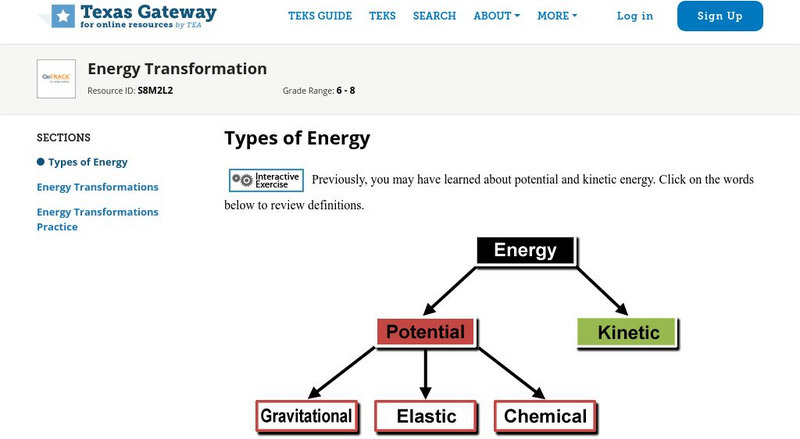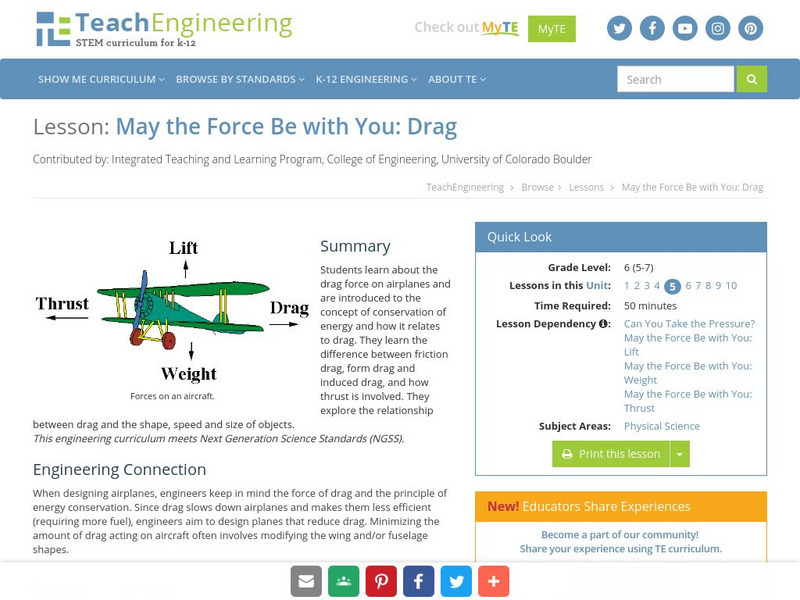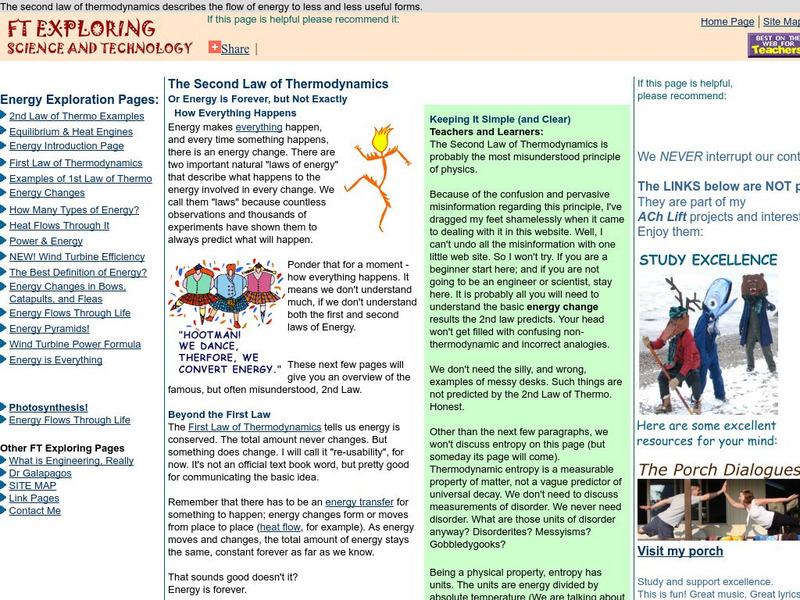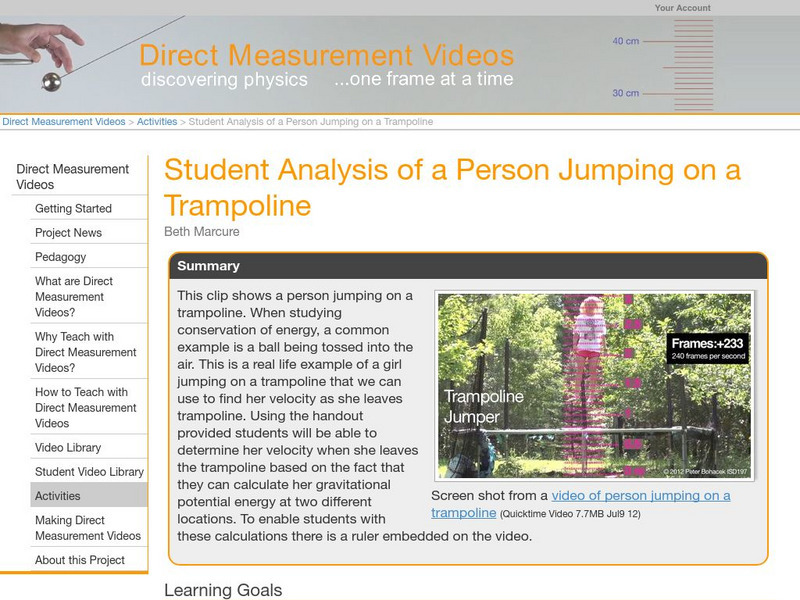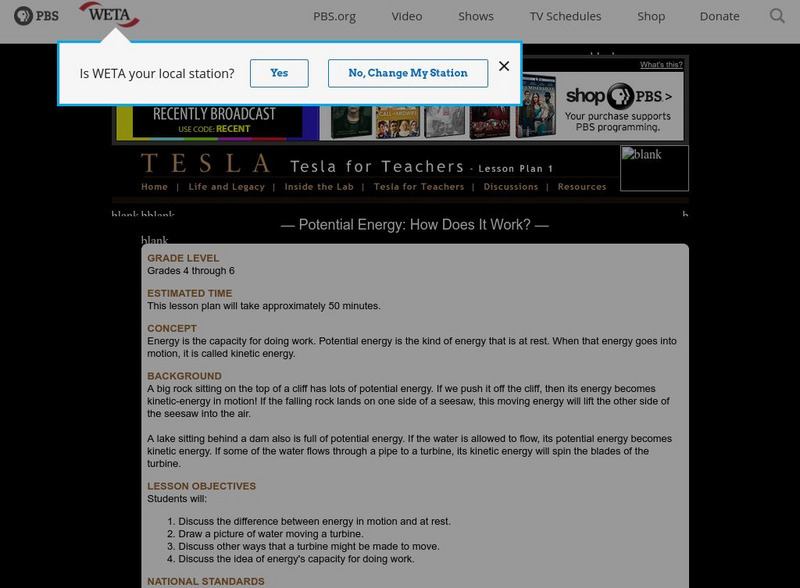Physics Classroom
The Physics Classroom: Work, Energy, and Power: Mechanical Energy Is Conserved
In this interactive exercise, explore the quantitative relationship between work and mechanical energy in situations in which there are no external forces doing work.
Museum of Science
Museum of Science and Industry: Online Science: Activities: Make an Egg Bungee
Step-by-step instructions, with photos, of how to prepare an egg for a 'bungee jump' using a plastic bag and elastics, and a yard stick to measure the distance it falls each time it is dropped. The activity investigates the Law of...
Open Curriculum
Open Curriculum: Thermodynamics
Students learn about the conservation of energy, aspects that affect energy in a system such as pressure and temperature, and to gain a better understanding of concepts such as entropy.
FT Exploring
Ft Exploring: Energy Conversions: Potential to Kinetic Energy
Find out how gravitational potential energy is converted to kinetic energy, then finally into low-grade thermal energy.
Texas Education Agency
Texas Gateway: Energy Transformation
Given descriptions, illustrations, or scenarios, students will identify energy transformations, such as how energy in a flashlight battery changes from chemical energy to electric energy to light energy.
Physics Classroom
The Physics Classroom: Work and Energy: Energy Transformation for a Dart
Consider an ordinary dart projected from a toy dart gun and moving through the air. Students analyze work and energy of the motion of the dart with this animation.
TeachEngineering
Teach Engineering: May the Force Be With You: Drag
This lesson plan explores the drag force on airplanes. The students will be introduced to the concept of conservation of energy and how it relates to drag. Students will explore the relationship between drag and the shape, speed and size...
Physics Classroom
The Physics Classroom: Work, Energy, and Power: Application/practice Questions
Through illustrated examples and practice problems, students apply the relationship between work and mechanical energy change to a variety of motion scenarios in order to test our understanding.
Texas Education Agency
Texas Gateway: Matter and Energy: Chemical Equations
Explore balanced chemical equations in this tutorial. Tutorial includes videos, interactive activities, and practice to help students understand balanced chemical equations and the Law of Conservation of Mass.
University of Colorado
University of Colorado: Ph Et Interactive Simulations: Masses and Springs
Use this interactive, animated lab to explore conservation of mechanical energy.
FT Exploring
Ft Exploring: The Second Law of Thermodynamics
Learn about one of the most misunderstood principles of physics, the second law of thermodynamics.
Science Struck
Science Struck: Law of Conservation of Mass Explained With Examples
Explains the Law of Conservation of Mass, or Law of Conservation of Matter, and gives two examples for it.
Physics Aviary
Physics Aviary: Energy Loss Lab
This lab is designed to have students investigate the amount of energy lost by a ball when it bounces. Students will change the starting height of the ball and see how this affects the amount of energy lost and the percent of the...
Physics Aviary
Physics Aviary: Guided Energy Loss Lab
This guided lab is designed to have students investigate the amount of energy lost by a ball when it bounces. This guided activity is meant to be used as a pre-lab for students who will do this lab live. Students will get a certificate...
Science Education Resource Center at Carleton College
Serc: Student Analysis of a Person Jumping on a Trampoline
For this activity, learners learn about conservation of mechanical energy as they measure the velocity of a girl jumping on a trampoline using a direct measurement video with an embedded frame counter and ruler.
TeachEngineering
Teach Engineering: How a Hybrid Works
In Lesson 4, young scholars conclude the Research and Revise step of the Legacy Cycle, as they investigate different forms of hybrid engines as well as briefly conclude a look at the different forms of potential energy. Students apply...
University of Colorado
University of Colorado: Ph Et Interactive Simulations: Masses & Springs
Hang various mass weights on spring scales while you adjust the spring stiffness and damping in this online activity. Slow down the action, take it to another planet, or watch the amount of potential, thermal, and kinetic energy.
University Corporation for Atmospheric Research
Ucar: Earth's Energy Balance
See how Earth's temperature would change if the Sun's brightness increased or dimmed or if Earth's albedo was different.
University of Colorado
University of Colorado: Ph Et Interactive Simulations: The Ramp
Which object takes more energy to push up a ramp: a file cabinet, a refrigerator, a piano, or a sleepy dog? Find out in this ramp simulation when you change the angle of the incline, change the objects, or change the friction on the ramp.
Ducksters
Ducksters: Physics for Kids: Energy
Kids learn about the science behind Energy including its different forms such as chemical, electrical, heat, and gravitational. When is energy considered renewable or nonrenewable?
PBS
Pbs Teachers: Potential Energy: How Does It Work?
Describe the difference between energy in motion and at rest, and demonstrate energy's capacity for doing work. Draw a picture of water moving a turbine, and discuss other ways that a turbine might be made to move.
E-learning for Kids
E Learning for Kids: Science: Mexican Diner: What Is Energy?
Meet Carlos at his Mexican diner, and he will tell all about energy and energy transformations.
Physics Aviary
Physics Aviary: Practice Problems: Energy on Incline Level 2
Students must predict the distance a box will move up an incline based on energy conservation. There will be friction present and some of the original KE will turn into heat.
NASA
Nasa: Kepler's Second Law
This site from NASA states Kepler's second law of planetary motion and depicts its meaning with an informative diagram. Relates the law to conservation of energy principles and discusses the eccentricity of a satellite's (or a planet's)...






